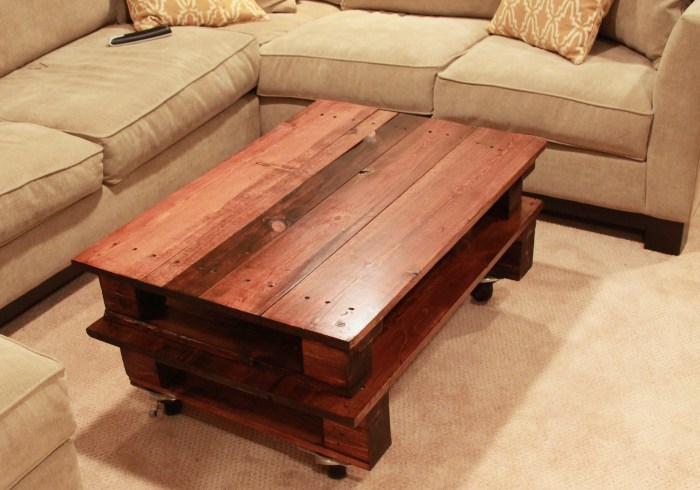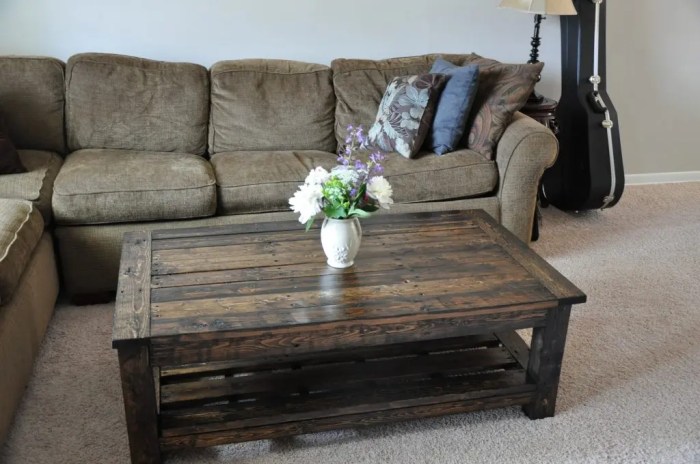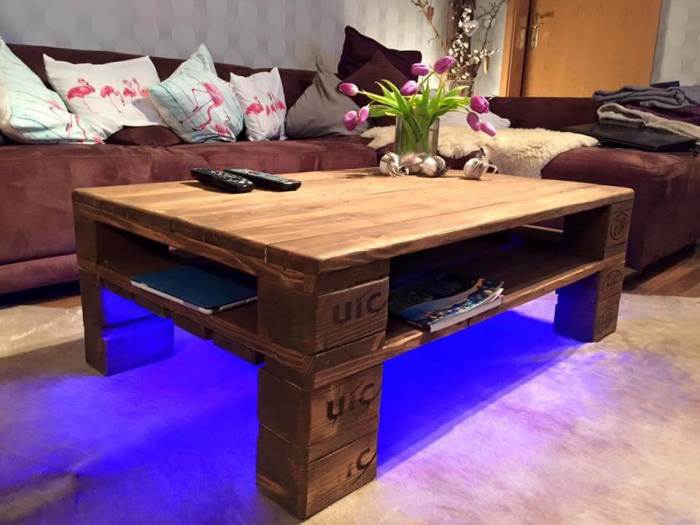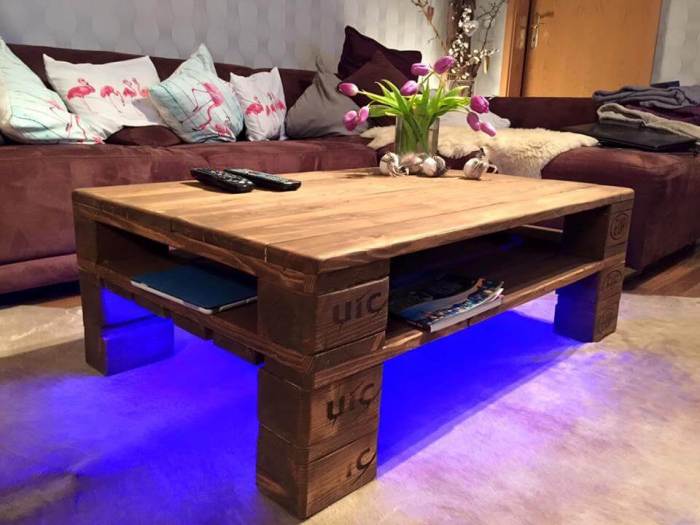DIY pallet coffee tables have become increasingly popular for their affordability, sustainability, and unique design possibilities. This project allows you to create a one-of-a-kind piece of furniture that reflects your personal style while reducing waste and embracing a more eco-conscious approach. The versatility of pallet wood makes it adaptable to various aesthetics, from rustic farmhouse to modern industrial, allowing you to seamlessly integrate your new coffee table into your existing décor.
Building a DIY pallet coffee table is a rewarding project that combines creativity and practicality. With a little planning and effort, you can transform a humble pallet into a functional and stylish centerpiece for your living room. Whether you’re a seasoned DIY enthusiast or a novice woodworker, this project offers a fun and accessible way to express your creativity and add a personal touch to your home.
Preparing the Pallet

Before you can start building your coffee table, you need to prepare your pallet. This involves disassembling it safely, cleaning the wood, and selecting the best boards for your project.
Disassembling the Pallet
Safety is paramount when disassembling a pallet. Start by wearing safety glasses and gloves to protect yourself from splinters and flying debris. You’ll need a hammer, crowbar, and possibly a nail puller to remove the nails and staples.
- Inspect the pallet: Look for any loose boards or damaged areas. If you find any, you may want to discard those boards or reinforce them before using them in your coffee table.
- Start with the nails: Use the hammer and crowbar to carefully pry the nails out of the pallet. If you have a nail puller, it can be helpful for removing stubborn nails. Be careful not to damage the wood as you remove the nails.
- Remove the staples: Staples are more challenging to remove than nails. Use a staple remover if you have one, or a pair of pliers to pull them out.
- Disassemble the pallet: Once all the nails and staples are removed, you can start disassembling the pallet. Start by separating the top and bottom boards, then remove the side rails.
Cleaning and Preparing the Pallet Wood
Once the pallet is disassembled, you need to clean and prepare the wood.
- Remove any dirt or debris: Use a brush or vacuum cleaner to remove any dirt, dust, or debris from the pallet wood.
- Sand the wood: Sanding the wood smooths out any rough edges and prepares it for finishing. Start with a coarse-grit sandpaper to remove any major imperfections, then use a finer-grit sandpaper to create a smooth finish.
- Remove splinters: Use a small chisel or a sharp knife to remove any remaining splinters.
- Fill any gaps or holes: If there are any gaps or holes in the wood, you can fill them with wood filler. Let the filler dry completely before sanding it smooth.
Selecting and Preparing the Best Pallet Boards
Not all pallet boards are created equal. Some are better suited for a coffee table than others.
- Look for boards that are straight and free of knots: These boards will be easier to work with and will create a more stable coffee table.
- Choose boards that are at least 1 inch thick: Thicker boards will be more durable and less likely to warp or sag.
- Avoid using boards that are heavily damaged or weathered: These boards may be too weak or brittle to use in your coffee table.
Design and Construction: Diy Pallet Coffee Table

Now that you have your pallet ready, it’s time to get creative and start designing your coffee table. You can choose from a variety of shapes, sizes, and styles, depending on your preference and the space you have available.
The construction process involves cutting, assembling, and securing the boards, but it’s essential to measure and align them accurately to ensure a sturdy and balanced table. Let’s dive into some design ideas and the step-by-step process of building your own pallet coffee table.
Design Ideas, Diy pallet coffee table
There are many design ideas you can explore for your pallet coffee table.
- Shape: You can keep the natural rectangular shape of the pallet or create a more unique design by cutting and assembling the boards into a square, round, or even a hexagonal shape.
- Size: The size of your table will depend on your needs and the space you have available. You can create a small table for a cozy corner or a larger table to accommodate more guests.
- Style: The style of your coffee table can range from rustic to modern. You can leave the pallet in its natural state, or you can stain or paint it to match your decor. You can also add decorative elements, such as legs, wheels, or a glass top.
Construction Process
The construction process for a basic pallet coffee table is straightforward.
- Cutting: You can use a saw to cut the pallet boards to the desired length and width. Make sure to wear safety goggles and gloves while cutting.
- Assembling: Once the boards are cut, you can assemble them into the desired shape. You can use wood glue and screws to secure the boards together. Make sure to pre-drill holes for the screws to prevent the wood from splitting.
- Securing: After assembling the table top, you can add legs or a base to support the table. You can use pre-made legs or create your own from scrap wood.
Measuring and Aligning
Measuring and aligning the boards accurately is crucial for ensuring a sturdy and balanced table.
- Measure Twice, Cut Once: This is a common saying in woodworking, and it’s essential to follow it. Measure the boards carefully before cutting them to ensure they are the correct size.
- Use a Level: Use a level to ensure that the table top is level and the legs are even. This will prevent the table from wobbling.
- Align the Boards: When assembling the table top, make sure the boards are aligned correctly. You can use clamps to hold the boards in place while you secure them with screws or glue.
Safety Considerations

Building a coffee table from a pallet is a fun and rewarding project, but it’s important to prioritize safety throughout the process. Working with wood and power tools requires a mindful approach to prevent injuries.
Handling Pallets
Pallets are often heavy and can have sharp edges or protruding nails. Always wear gloves when handling pallets to protect your hands. Before disassembling a pallet, inspect it for any loose boards or nails. Use a pry bar or hammer to remove nails carefully, ensuring you’re not standing directly in front of the pallet when prying.
Using Power Tools
Power tools can be dangerous if not used correctly. Always wear safety glasses to protect your eyes from flying debris. Use ear protection to reduce the noise and protect your hearing. When using a saw, ensure the blade is sharp and properly secured. Keep your fingers away from the blade’s path and use a push stick to guide the wood. Always unplug power tools when not in use.
Working with Wood Glue
Wood glue can be irritating to the skin and eyes. Wear gloves when applying glue and avoid contact with your skin. If glue gets on your skin, wash it off immediately with soap and water. Work in a well-ventilated area to minimize exposure to glue fumes.
Disposing of Wood Scraps
Dispose of wood scraps responsibly. Consider recycling or composting wood scraps if possible. If you’re discarding wood scraps, make sure they are properly disposed of in accordance with local regulations.
Creating a DIY pallet coffee table is a journey that combines creativity, resourcefulness, and a touch of rustic charm. By transforming discarded pallets into beautiful and functional furniture, you contribute to a more sustainable lifestyle while adding a unique touch to your home. Whether you choose a simple design or a more intricate one, the process is a rewarding experience that allows you to express your individuality and create a piece that you can cherish for years to come.
A DIY pallet coffee table can be a fantastic way to add a rustic charm to your living room. If you’re looking for some festive touches to add to your coffee table, consider making some pine cone ornaments to decorate it. These simple ornaments are perfect for a natural, woodland aesthetic, and they can easily be customized with paint, glitter, or other embellishments.
Once your ornaments are complete, you can display them on your pallet coffee table for a touch of seasonal cheer.

